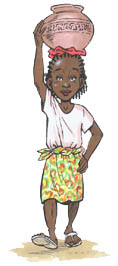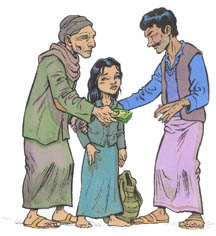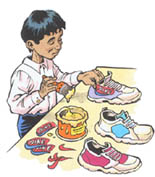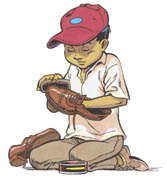Reference Texts
Common Forms of Child Labour

Return to Reference Texts
Child labour is a global problem, affecting industrialized countries as well as developing ones. Current estimates claim that at least 250 million children between the ages of 5 and 14 are forced to work, and that at least half of them are obliged to work full time.
Child labour comes in many forms, which are placed in seven categories:
- Domestic work
- Servitude
- Sexual exploitation for economic gain
- Work in industry or plantations
- Work in the street
- Family work
- Military work


Domestic Work
Domestic workers have a lot to do, including washing clothes, cleaning, and caring for children. Many domestic child workers sleep in the homes of their employers, and often on the floor. They are frequently required to work long hours, and many are denied access to education. These children are the most vulnerable and the most exploited, but also the most difficult to protect, since their working conditions depend entirely on their employer. Many suffer sexual and physical abuse.

Sexual exploitation for economic gain
Due to the secrecy of child sexual exploitation, reliable statistics about this multi-billion dollar industry are not easy to find. Non-Governmental Organisations, however, estimate that at least a million young girls are captured or forced into this type of exploitation and slavery each year around the world. Boys are also often targeted. Prostitution networks exist everywhere, though perhaps the most important region is Asia.
Physical and psychological harm make this type of exploitation extremely serious for children. Daily risks include HIV and other sexually transmitted diseases, unwanted pregnancies, drug addictions, and respiratory disease.


Servitude
The most common form of modern slavery is debt servitude. Poor families trade their child or children for money to property owners or businessmen, who use the extra hands in various trades, such as construction, textiles, and agricultural plantations. The child’s labour is rarely paid, and the servitude often lasts through generations.

Military work
Drafting children for the army has been practiced for centuries by many civilizations, but is nowadays considered a form of slavery, since the drafts are often mandatory. The UN claims that 300,000 youth under the age of 18 have participated or still do, in the 30 or so regional conflicts during the last few decades. They are recruited by the national army or by militias in the case of civil wars. They risk their lives, and are often beaten or killed if they attempt to escape.
UNICEF claims that children are often recruited because they are impressionable, sensitive to authority, and less likely to desert the army. They are able to perform many auxiliary tasks, and light arms have made them useful in the front lines. Girls are also used, often serving as sexual slaves.


Work in Industry or Plantations
All around the world children work in appalling conditions in factories and plantations, whether it be making bricks by hand in Peru and Colombia, or working with leather in Naples, Italy.

Family work
The most common occupation of children is still working for the family, including agricultural and household chores. Although helping with chores can give a child a sense of value, these chores are often quite demanding and the hours long. This work can easily prevent the child’s development and success at school.


Work in the street
The street can be dangerous and cruel, threatening even the lives of these children who could be polishing shoes, cleaning or guarding cars, carrying packages, selling flowers or knick-knacks, or collecting recyclables to sell. They work for their own survival, or that of their family, and can find a multitude of ways to make a bit of money. Most will return home in the evening, often in the slums.

|